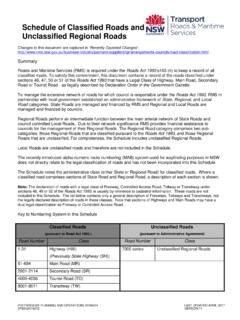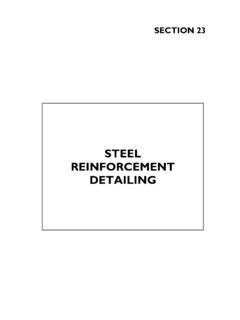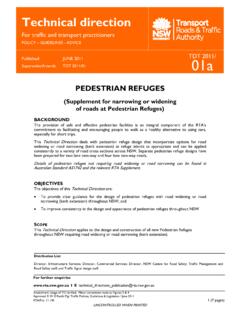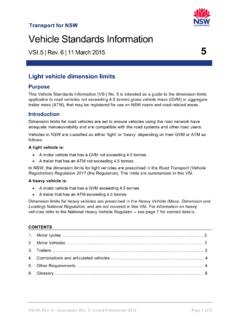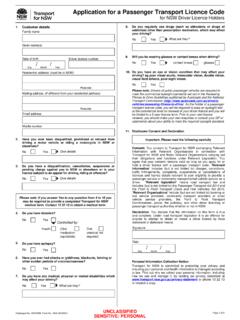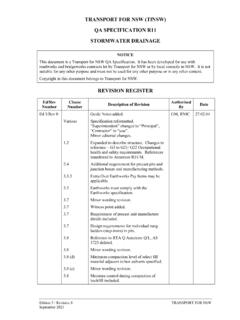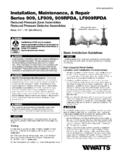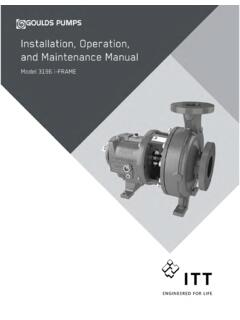Transcription of Installation and Maintenance of Signs - Transport for NSW
1 UNCONTROLLED WHEN PRINTED Installation and Maintenance of Signs Special Note: As from 17 January 2011, the RTA is adopting the Austroads Guides (Guide to Traffic Management) and Australian Standards (AS 1742, 1743 & 2890) as its primary technical references. An RTA Supplement has been developed for each Part of the Guide to Traffic Management and relevant Australian Standard. The Supplements document any mandatory RTA practice and any complementary guidelines which need to be considered. The RTA Supplements must be referred to prior to using any reference material. This RTA document is a complementary guideline. Therefore if any conflict arises, the RTA Supplements, the Austroads Guides and the Australian Standards are to prevail. The RTA Supplements are located on ii UNCONTROLLED WHEN PRINTED ISSUED: December 2010 AMENDMENTS: Refer to Amendment Record APPROVED BY: SIGNED Craig J Moran General Manager Traffic Management AUTHORISED FOR USE BY: SIGNED Mike Veysey Director Network Services 2010 Roads and Traffic Authority NSW Extracts from these guidelines may be reproduced providing the subject is kept in context and the source is acknowledged.
2 Every effort has been made to supply complete and accurate information. However RTA, NSW assumes no responsibility for its use. All trade name references herein are either trademarks or registered trademarks of their respective companies. For policy and technical enquiries regarding these guidelines please contact: Traffic Engineering Services Branch Email: To access electronic copies of these and other guidelines go to: iii UNCONTROLLED WHEN PRINTED Installation & Maintenance of Signs Contents 1 Introduction .. 1 Scope .. 1 Responsibilities and authorisation .. 1 Inspection of Signs .. 1 Procedure for new sign placement .. 1 2 sign Selection .. 2 General .. 2 Regulatory, warning and temporary/road works Signs .. 2 Guide Signs .. 2 Panel 2 Temporary/road works Signs .. 2 Permanent Signs .. 3 sign face material .. 3 Non Standard Signs .. 3 Other Signs .. 3 3 sign Supports and Footings .. 3 General .. 3 Wind loading.
3 4 sign support basics .. 4 Galvanised steel tube posts .. 4 Deflection .. 5 Footings .. 5 Proprietary frangible post structures .. 6 Modular structures .. 6 Multiple Signs .. 6 Fittings and sign mounting .. 7 sign panel reinforcing channel extrusion centre guide .. 7 Manufacture and delivery .. 7 Signs on bridges .. 7 4 Modular sign Structures .. 8 5 Locating Signs .. 17 iii UNCONTROLLED WHEN PRINTED Installation & Maintenance of Signs General considerations .. 17 Utilities in footways .. 18 sign placement .. 19 Lateral clearance and height .. 19 Longitudinal placement .. 20 Clear zone .. 20 Signs in medians and islands .. 20 Orientation of Signs .. 20 6 Installation of 26 Storage of Signs .. 26 Transporting of sign panels and structures .. 26 Modular and special structures .. 27 Mounting of sign panels .. 27 Offset Signs .. 27 Recording of sign Installation approvals .. 27 Recording of sign Installation details.
4 27 7 sign Life Cycle Management .. 28 General .. 28 Why inspect? .. 29 Inspection items .. 29 sign face 30 8 Maintenance .. 38 Introduction .. 38 Maintaining sign supports .. 38 Posts, large cantilevers and gantries .. 38 Bolts and brackets .. 38 Maintaining sign panels .. 39 Normal washing .. 39 Paint or graffiti damage .. 39 Other deposits .. 39 Fading and loss of colour .. 40 v UNCONTROLLED WHEN PRINTED Installation & Maintenance of Signs Figures Figure Single Post Selection Chart .. 9 Figure Two Post Selection Chart .. 10 Figure Three Post Selection Chart .. 11 Figure Footing details for sign support .. 13 Figure sign mounting assemblies small Signs .. 14 Figure Stock predrilled 50 mm NB posts .. 15 Figure Traffic facilities stems .. 16 Figure Public utility mains allocation of space in footways (1) .. 22 Figure Public utility mains allocation of space in footways (2) .. 23 Figure Public utility mains allocation of space in footways (3).
5 24 Figure Disposition of sign panels .. 25 Figure Signposting audit report .. 32 Figure Level 1 Structural Inspection Check Sheet .. 33 Figure Level 2 check list for major structures (1) .. 34 Figure Level 2 check list for major structures (2) .. 35 Figure Flowchart for Updating TAIMS .. 36 Figure TAIMS Update Form .. 37 Tables Table Signposting audit checklist .. 31 UNCONTROLLED WHEN PRINTED Installation & Maintenance of Signs Amendment record Please note that the following updates have been made to this document. Amendment No Page Description Issued Approved By 1 17 Height of sign shown in dot points amended to April 2011 R O Keefe Mgr Traffic Policies, Guidelines & Legislation 2 3 19 Various TD Reference updated to TTD 2013/08 Orientation of Signs , Figure (Reference ) Reference Hyperlinks updated November 2013 R O Keefe Mgr Traffic Policies, Guidelines & Legislation 3 4 6 9- 12 Various 20 Steel tube post sizes deemed frangible referenced Proprietary frangible post products referenced Steel tube post sizes deemed frangible shown in shaded area on post selection charts.
6 Notes associated with frangible post sizes added. References to proprietary frangible post products Clear zone design reference updated March 2014 R O Keefe Mgr Traffic Policies, Guidelines & Legislation vi UNCONTROLLED WHEN PRINTED Installation & Maintenance of Signs 1 Introduction Scope These guidelines set out procedures for the Installation and Maintenance of Signs and their supporting structures. Responsibilities and authorisation The responsibility for Installation of road Signs is vested with the roads authority which controls the road - either the Roads and Traffic Authority NSW (RTA) or the local Council. The RTA is responsible for classified roads and Local Government (Council) is responsible for unclassified roads. All changes to road Signs requires appropriate authorisation by the responsible authority. Inspection of Signs The appropriate roads authority must regularly inspect and keep an inventory of the Signs on its roads.
7 Inspections should review the suitability of each sign , the condition of the sign and its supporting structure as well as reviewing the need for additional Signs . Inspections should also consider the need to retain the sign and its position in relation to the clear zone. If a sign is within the clear zone and it is not frangible, determine if the sign should be removed, relocated, made frangible or protected. Procedure for new sign placement The steps involved in placing a new sign are:- 1. When the need for a new sign is perceived, determine the type of sign , its legend and position, especially with respect to the clear zone. 2. Prepare environmental assessment if required and undertake any consultation necessary. 3. Obtain approval for the sign design in accordance with current RTA policy. 4. Examine the site to ensure that the sign can be placed in the specified location especially with respect to the location of services. 5. AUTHORISE THE Installation OF THE sign 6.
8 Determine the type of support structure required. This will depend on the size of the sign face, its height and, if cantilevered, the distance from the centre of the post to the centre of the sign . Refer Section 5 7. Determine the size of footing required. Refer Section 3 1 UNCONTROLLED WHEN PRINTED Installation & Maintenance of Signs 8. Order the design of the sign face and support structure. 9. Order the manufacture of the sign face and support structure. 10. Prepare the site for Installation . 11. Assemble the structure and install the sign face. 12. RECORD DETAILS OF sign Installation (DATE/TIME ETC) 13. Inspect, maintain and repair the sign as necessary. Signs should be tracked as part of the asset life cycle management, by documenting as in Section sign Selection 2 sign Selection General The RTA maintains an electronic register of all standard Signs . Access to the RTA Traffic Signs Register is available via:- Regulatory, warning and temporary/road works Signs Most regulatory (including parking), warning and temporary Signs are of a standard design as required by AS 1742 and detailed in AS 1743.
9 Signs are generally available in several standard sizes. Refer to the RTA Traffic Signs Register for sizes, details and illustrations of these Signs . Guide Signs Most guide Signs have a generally standard layout but require individual design to suit the particular circumstances of the site. Refer to the RTA document, Guide Signposting, for further information or contact the RTA s Manager, Traffic Policies, Guidelines & Legislation, Traffic Management Branch. Panel material Temporary/road works Signs Temporary Signs for road works have traditionally been fabricated using bond wood (plywood) as the sign substrate. However, suitable good quality material is becoming difficult to source. Most road works Signs are now fabricated from Colorbond steel (boxed edge) or from the same aluminium used for permanent Signs . Refer to RTA Specification QA 3400 Section for further details. 2 UNCONTROLLED WHEN PRINTED Installation & Maintenance of Signs Permanent Signs Permanent sign blanks are manufactured from an aluminium alloy (type 5251 or 5052 & temper H38) with a thickness of Aluminium sign panels wider than 750mm are reinforced to limit deflection about the vertical axis with aluminium channels (extrusion) attached to the sign during manufacture.
10 The vertical spacing of channels is detailed in the RTA s Specification QA 3400. sign face material sign Face materials must be in accordance with: RTA Specification QA 3400, Manufacture and Delivery of Road Signs ; and TTD 2013/08, - Approved Retro-reflective Sheeting Materials for Road Signs ( ) Non Standard Signs For Signs not listed in the RTA's Traffic Signs Register or listed as No Longer Used, Not Used in NSW or Superseded, the advice of the RTA s Manager Traffic Policies, Guidelines & Legislation, Traffic Management Branch must be sought if an alternative is not shown. Other Signs Other Signs which are outside the scope of this document include, but are not limited to Variable Message Signs (VMS) both fixed and mobile, Variable Speed Limit Signs (VSLS), changeable message Signs (such as prism Signs ) and illuminated tunnel and bridge Signs . 3 sign Supports and Footings General The four basic types of sign supports are: 1. galvanised steel tube (the great majority) 2.
